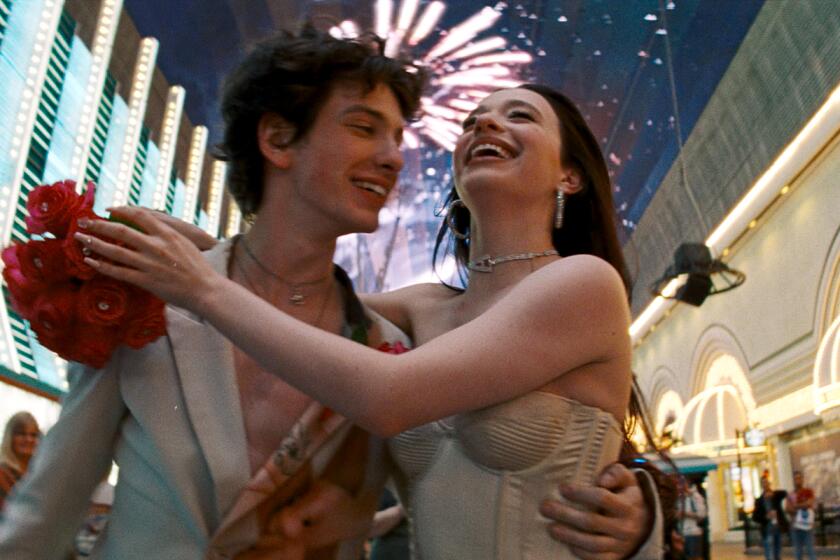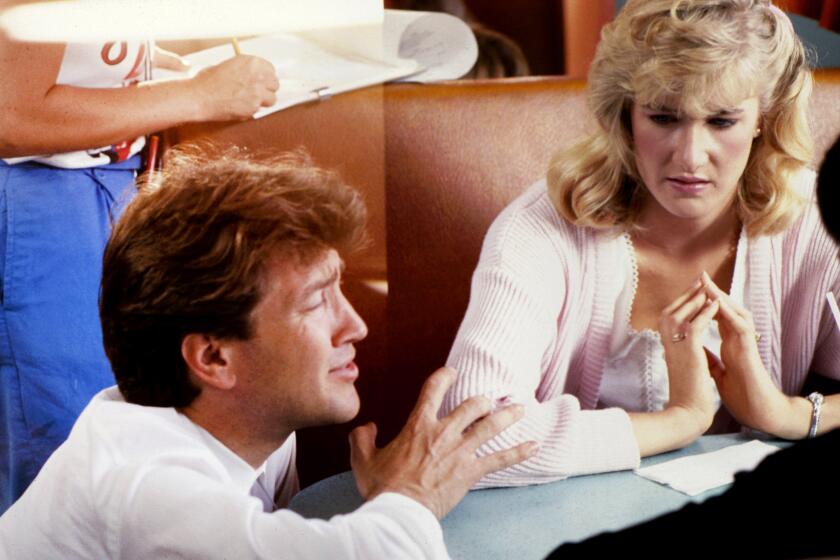Her double vision
- Share via
IN her memoir, “A Killer Life,” independent film producer Christine Vachon tells how her directing dreams died. It’s not depressing, but hopeful: An artist realizes her strengths, and one of independent cinema’s most fruitful relationships is born. But that’s the kind of statement Vachon, thoroughly unsentimental, would dismiss with an eye roll.
After graduating from Brown in the ‘80s, the New York native made short films with titles such as “Don’t Look Up My Skirt Unless You Mean It.” Her focus on gender politics changed when she saw good friend and former classmate Todd Haynes’ “Superstar: The Karen Carpenter Story.” Vachon was floored by the film, which enacted the singer’s battle with anorexia with dolls. “I knew my days as a director were essentially over,” she writes. “I wanted to take Todd’s ideas and make them happen.”
Since then, Vachon has raised money for all of Haynes’ projects, many of them difficult, controversial and critically baffling, at least at the time of release. For the Jean Genet-inspired triptych “Poison,” Haynes was lambasted (or complimented, as Vachon sees it) as the “Fellini of fellatio.” Haynes’ current project, “I’m Not There,” is no different: The film’s subject, Bob Dylan, is played by seven actors, including Cate Blanchett.
With the now-defunct Apparatus and her current business, Killer Films, Vachon has also produced her fair share of hits. Haynes’ Sirkian melodrama, “Far From Heaven,” racked up four Academy Award nominations and “Boys Don’t Cry” grabbed Hilary Swank her first Oscar.
Vachon spoke about “A Killer Life” after returning from the Venice Film Festival, where she was promoting “Infamous,” based on George Plimpton’s book about Capote that’s been all but buried by that other film with Philip Seymour Hoffman.
How long did it take you and co-writer Austin Bunn to write “A Killer Life”?
About three years. Every time we started to feel like we were getting near the end, there’d be another twist. “A Home at the End of the World” ended up not doing any business so it was like, “Do we put it in the book or not?” I still think that chapter is fascinating, and if it makes more people see a movie that I’m really proud of, that’s great. But we didn’t want to devote a ton of the book to movies that people didn’t see.
The book features entries from various production diaries. Do you always keep journals?
I don’t really. I mean, who wants to read that? All production diaries are the same: “It was hard but somehow we succeeded.” I just went back and wrote what I remembered.
Yet, from reading those entries, you really get the sense that there’s no typical producing experience.
No, that’s sort of the miserable part of it. You learn something new on each movie and it’s not something you ever knew that you had to know. It doesn’t get any easier. I’m older, and my stamina for being on a film set for 14 hours is less. Having a 7-year-old daughter has also made it about 100 times harder but it’s also great to have a reason to leave.
What does independent film mean now?
It’s films made with a singularity of vision. Films made by Todd Haynes could only be made by Todd Haynes. I don’t want to bite the hand that feeds me, but the fact that there’s a company called Warner Independent [Pictures] is an oxymoron to me. The so-called classics divisions at the studios, that essentially means making movies cheaper. Where the money comes from plays less and less a key factor.
How has the definition of producing changed?
In these films that are financed in, shall we say, creative ways, the list of producers and executive producers is the longest list in the credits. A producer credit should have weight. Let’s look at it this way: If I wanted to help you finance your movie and I say, “Hey, there’s just one catch: I want to share the director’s credit,” you’d be like, “What are you, nuts?” At the same time, if I have to hand out producer credits like M&M;’s to get a movie financed, I do it.
You’ve always been linked with the so-called gay cinema movement. Do you like that identity?
I used to feel it was reductive. But now, I really don’t care. I feel like in some ways those early so-called gay movies had a sense of urgency that was directly related to the AIDS crisis. That’s all changed now. In those days, there was no “Will & Grace.” Now there’s “Queer Eye” and all that crap, which just informs everything, even as the country marches ever-steadily to the right. It’s a different time.
You have a philosophy that the enemies you make can be just as important as the friends.
Today isn’t a good enemy day for me. There are some companies we’ve done business with in the past that are coming back to bite us. It’s very hard for me to not tell people what I think. Sometimes I just have to be careful. I wish we didn’t have any enemies. We don’t really. It would be hard for Killer Films to have enemies because we’re on a mission from God [laughs], you know what I mean? We’re working to keep this kind of singular, provocative vision of filmmaking alive.
What movie do you have the most regrets about?
I felt like “Velvet Goldmine” didn’t find its audience theatrically in a way that it deserved. Same with “Safe.” But both have an extraordinarily rich DVD/video shelf life, so they eventually found audiences.
How do you cope with all the ups and downs of producing? What do you do to relax?
I guess I just don’t. Sometimes I think up elaborate fantasies about how I’ll be able to retire. My current one is that I buy a vineyard.
Where?
I don’t care where. Anywhere I can afford it.
-- Margaret Wappler
More to Read
Only good movies
Get the Indie Focus newsletter, Mark Olsen's weekly guide to the world of cinema.
You may occasionally receive promotional content from the Los Angeles Times.








